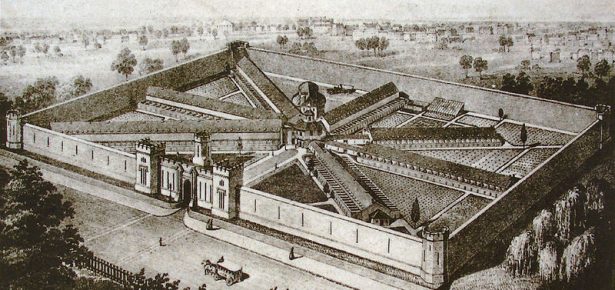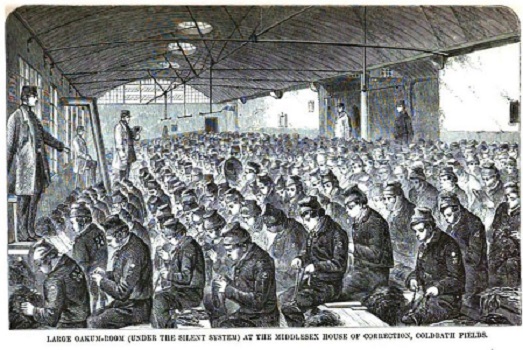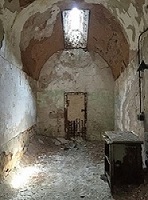
When British author Charles Dickens visited the United States in 1842, there were two destinations he had his heart set on visiting: Niagara Falls and Eastern State Penitentiary.
Opened in 1829, Philadelphia’s Eastern State Penitentiary was one of the most famous prisons of the early and mid-nineteenth century. But Dickens was not pleased with his visit. Already in a foul mood from his trip and his growing distaste for Americans, Dickens was horrified by what he found in Philadelphia.
Prisoners at Eastern were kept in solitary confinement for the duration of their prison sentence. To accommodate this condition, Eastern’s cells were fairly large both for the time and by today’s standards, and there was a small private yard attached to each cell for more fresh air and exercise. Prisoners worked in their cells making shoes, chairs, cabinets, weaving, or performing other crafts. Prison guards came by the cells to teach prisoners how to do this work, and the prison’s minister and other approved visitors taught prisoners to read and write and gave them lessons in Christian morality. Prisoners could also read in their spare time.
But solitary confinement had a complicated status in the nineteenth century.
On the one hand, every prison in America used solitary confinement of some kind. It’s just that most prisons kept their prisoners in solitary only at night. During the day, most prisoners worked silently in large factory-like rooms. This was known as the Auburn System, after Auburn State Prison in upstate New York.

On the other hand, earlier experiments with solitary confinement had been deadly and many still believed solitary confinement around the clock was dangerous and cruel.
In the 1810s and 1820s, solitary confinement was thought to be the perfect mode of confinement for the country’s newly built prisons. Earlier prisons, built in the 1790s and early 1800s, had erupted in riots, prisoners had set the prisons on fire, and escapes were all too common. These prisons were declared a failure and a new model of prison had to take its place. Reformers, prison administrators, and politicians alike thought solitary confinement would provide the perfect level of control—preventing prisoner misbehavior—and the perfect conditions for prisoner rehabilitation.
But the first experiments with long-term solitary confinement, conducted in the early 1820s, had gone horribly wrong. Prisoners were kept in tiny cells and given nothing to do. Many died, attempted suicide, engaged in self-harm, or otherwise became physically ill. Some prisoners who were released unharmed went right back to committing crime.
Despite these bad outcomes, reformers and prison administrators still thought solitary confinement held the key to the new prisons. So they moderated their use of solitary confinement: under the Auburn System, it was only used at night; under the Pennsylvania System (in use at Eastern), prisoners would have things to do, live in larger cells, and receive weekly visits from approved personnel.
While solitary at night was viewed as a good compromise, many believed that solitary around the clock was far too cruel, never mind the activities, visits, and fresh air prisoners had access to. Dickens was one such believer.
To Dickens, this approach was “immeasurably worse than any torture of the body.” According to him, “there is a depth of terrible endurance in it which none but the sufferers themselves can fathom, and which no man has a right to inflict upon his fellow-creature.”
Dickens was not alone in having these views. Criticism of Eastern State Penitentiary was so strong that when new states built prisons, and their creators also toured the existing prisons, they always chose the Auburn System as their model. By the end of the Civil War, Eastern State Penitentiary was the last American prison to follow the Pennsylvania System, which it continued to do until 1913.
Although Eastern is no longer a functioning prison, it still stands today and is open to the public as a tourist attraction. A curious visitor can stand inside one of its cells and decide for themselves if Dickens was right: is long-term solitary confinement unacceptably cruel?

Latest Comments
Have your say!